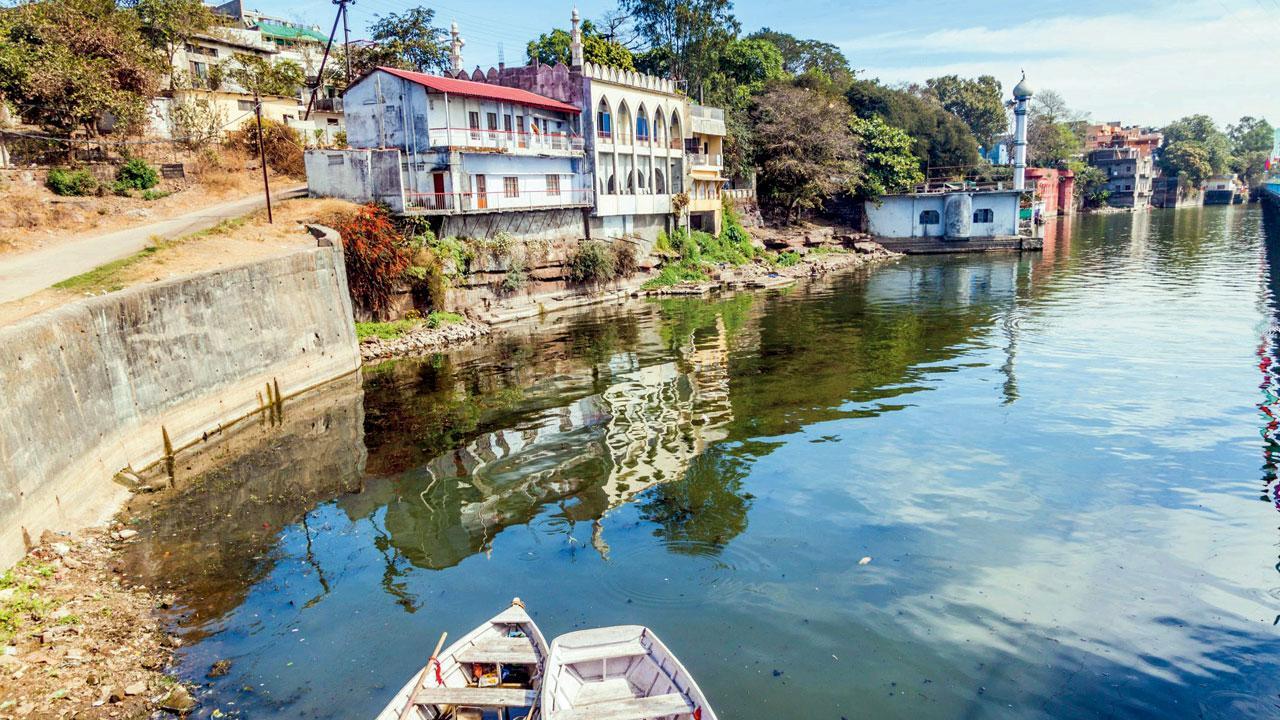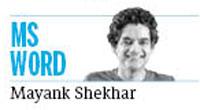Do you have a favourite Indian state capital? Srinagar doesn’t count, for now. I’ll go with Bhopal!

The Bada Talab, formerly known as Upper Lake, in Bhopal, Madhya Pradesh
 Two pals from Bhopal separately tell me about suicides in their lakes, because of Sonali Bendre, presumably in the ’90s, and Katrina Kaif, around 2012. Both Bollywood stars were once in Bhopal. Said Bhopalis couldn’t meet them. So, they drowned themselves, apparently!
Two pals from Bhopal separately tell me about suicides in their lakes, because of Sonali Bendre, presumably in the ’90s, and Katrina Kaif, around 2012. Both Bollywood stars were once in Bhopal. Said Bhopalis couldn’t meet them. So, they drowned themselves, apparently!
ADVERTISEMENT
Which tells me less about fascination for Bollywood stars, as suicides, perhaps—while I hear more personal anecdotes. The origin of the Nawabi Bhopal itself involves death by suicide of the Gond Queen Kamlapati, married to King Nizam Shah.
To protect her sovereignty after the husband’s murder, Queen Kamlapati enlisted services of Dost Mohammad Khan, a mercenary from the Mughal army. Khan (1657-1728), unlike a dost, eventually usurped the kingdom.
Kamlapati took ‘jal samadhi’ in the waters of Bhopal. Guessing, in the lake. Of which there are 17, currently. Plus, five dams, that ‘Bhopal’ is apparently named after—from Bhoj-pal, or the dam of Malwa’s Raja Bhoj, who ruled, mid-11th century.
There’s the huge statue of Raja Bhoj—none for Gangu Teli, of course—on Bhopal’s biggest lake, aptly called Bada Talab. Around the statue is the equally self-explanatory, Very Important Persons’ (VIP) Road.
The water is supposedly deepest by the statue. A bridge planned through the lake, authorities reckon, must avoid deeper parts. So Bhopalis don’t jump over! Yo, what’s up?
Surrounded by hills, forests, lakes, general greenery, is Bhopal the finest Indian state capital? Since Srinagar, as we speak, headquarters the union territory of J&K, Madhya Pradesh’s capital must win.
In some ways, the all-weather Bhopal, as a retiree’s ideal address, mirrors what Bengaluru, Pune were in the 1980s—before ‘Punengaluru’ exploded in subsequent decades. Besides, you’re seeped in history, plus all religions, for stay, and pray-cations.
Bharat Bhawan, for arts and theatre, is a cultural marvel. Publishing scene is relatively upbeat. Mumbai’s film/OTT industry, evidently, loves to shoot in Bhopal. Homes aren’t skyscrapers. There’s a delightfully small-town feel.
What about the people? Wherever my eyes go, I only observe suitably homogenised, urban young, from across the state, and beyond, doing the usual youngling things, at malls, promenades, eateries. Given the number of private colleges in Bhopal that, I’m told, also border on money-making rackets.
That said, the Bhopali got made nationally famous by Soorma (Jagdeep) in Sholay (1975)—the character, based on an actual person, invented by Javed Akhtar, once a Bhopali himself.
Soorma is characterised by tall-talk, spinning yarns, being generally laidback. Which anecdotally matches self-description of older Bhopalis still.
During a talk on Indrajit Hazra’s book, In Praise of Laziness, at the Bhopal Literature Festival, a gentleman apprises us of Dar-ul-Kohla, India’s first club for slackers.
It began in Bhopal in 1930s. Membership fee was a pillow. People rolled on the floor, into the club, for meetings. It definitely shut down, because they were too lazy to run it for long!
How about that OG Bhopali then, with the peculiar twang, penchant for exaggerations? A local gent I met, years ago, described everything around us as “Asia’s” largest/deepest/smallest? They are likely to be found in the ‘City’, I’m told. Meaning, Old Bhopal; quite similar to Delhi’s walled city.
A lot of the charm and architecture of these parts can be attributed to four Begums (early 1800s onwards), who ruled Bhopal, in succession, once it became a British regency. Assured of imperial protection, in terms of wars/fratricide, I suspect, the begums could look at making Bhopali life better.
Post-independence, Bhopal got widely known, globally, for the 1984 gas tragedy. It’s a shame. A top American executive wondered to me recently about how much money the firm Union Carbide must have paid off to rename the fatal methyl-isocyanate leak from its pesticide plant as the Bhopal Gas Tragedy.
Initially, the American exec knew it to be the Union Carbide disaster. That factory stands, as is, still contaminating the soil beneath it. Culprits got away. Bhopalis got no closure.
To digress, about 200 km from the tragic topic, what do you reckon is India’s night-life capital? Depends on how you define nightlife; i.e., not pubs/nightclubs.
But, generally, people, in fair gender ratios, up and about in their city, before crack of dawn, safely hanging around, hogging street-food, their prime addiction, mostly laced with sev?
Indeed, the outdoorsy Indore. It’s perhaps to Bhopal, what Surat is to Ahmedabad (in Gujarat), or Mumbai is to Delhi (for India)—equations defined in terms of commerce and politics.
The ‘City’ side of Bhopal too has forever been known for its late-night Suleimani tea and kabab shops. After the usual bar-hop in Bhopal, I rest my liver to make space for other species’ body parts. We head to the City. It’s all shut, around midnight. The streets have no game.
Don’t know, maybe this is a post-pandemic phenomenon—you could notice this anywhere between Brazil and Bombay. Or perhaps, this has something to do with a new government’s rules, mandated to suck the joy out of people’s lives—banning sale of meat by vendors, or decreeing a shutter-down, by 10 pm?
Speaking of the latter, may I guide you to the bar with the best view in a state capital—the massive Wind & Waves, overlooking Bada Talab with Begum’s lit jewels (for Marine Drive’s Queen’s Necklace) panoramically across. Splendid. It’s run by the govt.
Mayank Shekhar attempts to make sense of mass culture. He tweets @mayankw14
Send your feedback to mailbag@mid-day.com
The views expressed in this column are the individual’s and don’t represent those of the paper.
 Subscribe today by clicking the link and stay updated with the latest news!" Click here!
Subscribe today by clicking the link and stay updated with the latest news!" Click here!







